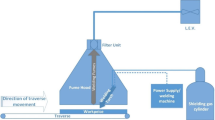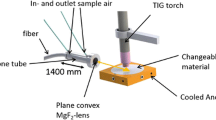Abstract
Objective
This work was performed to assess welder exposure to NO and NO2 and to assess the importance of these gases in the hierarchy of contaminants produced during welding (GMAW [MIG welding], GTAW [TIG welding], plasma cutting) on aluminum alloys.
Methods
Personal air samples in the breathing zone were collected on welders using a small, person-portable, direct-reading, datalogging instrument containing an electrochemical sensor rated for NO2 and colorimetric detector tubes rated for NO to assess exposure during welding.
Results
Exceedance of the Threshold Limit Value -Time-Weighted Average (TLV-TWA) of 0.2 ppm (parts per million) averaged over 8 hours for NO2 and the Ceiling Limit of 1 ppm used by some jurisdictions was likely during GTAW (TIG welding) in poorly ventilated conditions. Exceedance of these limits was unlikely during plasma arc cutting and GMAW (MIG welding). Exceedance of the TLV-TWA of 25 ppm for NO was unlikely to occur.
Conclusion
Exceedance of the TLV-TWA of 0.2 ppm and the Ceiling Limit of 1 ppm mandated in some jurisdictions for exposure to NO2 during argon-shielded GTAW on aluminium alloys is likely to occur in the shipyard environment examined during this study. Exceedance of Exposure Limits for NO2 during GMAW or plasma arc cutting is unlikely to occur. The critical substance at the top of the exposure hierarchy involving a complex mixture could be a gas. As well, this substance could be process-specific (GTAW versus GMAW). This situation illustrates the importance of monitoring worker exposure in consideration about the likelihood of exceedance of Exposure Limits and identification of critical substance(s) in the hierarchy of contaminants produced during a process.
Similar content being viewed by others
References
NIOSH (National Institute for Occupational Health and Safety). Criteria for a Recommended Standard, Welding, Brazing, and Thermal Cutting (DHHS (NIOSH) Publication No. 88–110), https://www.cdc.gov/niosh/ docs/88–110a/pdfs/88–110A.pdf (1988).
Seinfeld, J. H. in Air Pollution: Physical and Chemical Fundamentals (McGraw–Hill Inc., USA, 1975).
Perkins, H. C. in Air Pollution (McGraw–Hill Inc., USA, 1974).
McManus, T. N. & Haddad, A. N. UV and Blue Light Exposures in an Aluminum Shipbuilding Environment. Int. J. Open Sci. Res. 1, 15–27 (2013).
McManus, T. N. & Haddad, A. N. Use of Methanol as a Coolant during Machining of Aluminum in a Shipbuilding Environment: A Failure to Assess and Manage risk. Adv. Mat. Res. 955–959, 1061–1064 (2014).
McManus, N. & Haddad, A. N. Oxygen Levels during Welding Assessment in an Aluminum Shipbuilding Environment. Prof. Safet. 60, 26–32 (2015).
McManus, N. & Haddad, A. N. Argon–related Fatigue: An Investigation in an Aluminum Shipbuilding Environment. Prof. Safet. 60, 47–55 (2015).
McManus, T. N. & Haddad, A. N. Chromium Emissions during Welding in an Aluminum Shipbuilding Environment. Weld. J. 95, 86–92 (2016).
McManus, T. N. & Haddad, A. N. Ozone: a critical contaminant produced during gas metal arc welding (GMAW) on aluminum alloys—resolving the shortversus long–duration sampling discrepancy. Air Qual. Atm. Health Online First, doi: 10.1007/s11869–018–0634–9 (2018).
ACGIH (American Conference of Governmental Industrial Hygienists). in Documentation of the TLVs and BEIs; Nitric Oxide (American Conference of Governmental Industrial Hygienists, USA, 2001).
ACGIH (American Conference of Governmental Industrial Hygienists). in Documentation of the TLVs and BEIs; Nitrogen dioxide (American Conference of Governmental Industrial Hygienists, USA, 2001).
ACGIH (American Conference of Governmental Industrial Hygienists). in TLVs and BEIs for Chemical Substances and Physical Agents & Biological Exposure Indices (American Conference of Governmental Industrial Hygienists, USA, 2014).
WorkSafeBC. Occupational Health & Safety Regulation, Part. 5, Chemical Agents and Biological Agents (BC Regulation 296/97, as amended), http://www2.worksafebc. com/publications/OHSRegulation/Introduction. asp#AboutOccupationalHealthSafetyRegulation (2018).
AIHA (American Industrial Hygiene Association). in A Strategy for Assessing and Managing Occupational Exposures, 4th edn (eds Jahn, S. D., Bullock, W. H. & Ignacio, J. S.) 361–453 (American Industrial Hygiene Association, Falls Church, VA,2015).
AIHA (American Industrial Hygiene Association). Mathematical Models for Estimating Occupational Exposure to Chemicals, 2nd edn (eds Keil, C. B., Simmons, C. E. & Anthony, T. R.) 337–347 (American Industrial Hygiene Association, Fairfax, VA,2009).
Bollinger, N. NIOSH Respirator Selection Logic (DHHS (NIOSH) Publication No. 2005–100), http:// www.aresok.org/npg/nioshdbs/docs/2005–100/chapter6. html (2004).
NIOSH (National Institute for Occupational Safety and Health). NIOSH Pocket Guide to Chemical Hazards (DHHS (NIOSH) Publication No. 2005–149), https:// www.cdc.gov/niosh/docs/2005–149/pdfs/2005–149.pdf (2007).
AIHA (American Industrial Hygiene Association). in Respiratory Protection, a Manual and Guideline (American Industrial Hygiene Association, Fairfax, USA, 2001).
3M Occupational Health and Environmental Safety Division. in 2010 Respirator Selection Guide (Minnesota Mining and Manufacturing, St. Paul, MN,2010).
Lynch, J. R. in Patty’s Industrial Hygiene and Toxicology, 3rd edn (eds Harris, R. L., Cralley, L. J. & Cralley, L. V.) 27–80 (John Wiley & Sons, Inc., USA, 1994).
Goller, J. W. & Paik, N. W. A Comparison of Iron oxide Fume Inside and Outside of Welding Helmets. Am. Indust. Hyg. Assoc. J. 46, 89–93 (1985).
Liu, D., Wog, H., Quinlan, P. & Blanc, P. D. Welding Helmet Airborne Fume Concentrations Compared to Personal Breathing Zone Sampling. Am. Indust. Hyg. Assoc. J. 46, 280–283 (1995).
Swint, W. ESAB’s partnership with Canada’s west coast shipbuilding industry. Pacificat 1000 series high speed ferry. Svetsare. 54, 28–30 (2000).
CSA Group. Certification of Companies for Fusion Welding of Aluminum (CAN/CSA W47.2–11), https:// www.cwbgroup.org/certification–and–qualification/csaw472–fusion–welding–aluminum–company–certification (2011).
ASME (American Society of Mechanical Engineers). in 2010 ASME Boiler and Pressure Vessel Code. IX Qualification Standard for Welding and Brazing Procedures, Welders, Brazers, and Welding and Brazing Operators (American Society of Mechanical Engineers, USA, 2010).
Gastec. in Gastec Environmental Analysis Technology Handbook (Gastec Corporation, Japan, 2012).
Author information
Authors and Affiliations
Corresponding author
Rights and permissions
About this article
Cite this article
McManus, T.N., Haddad, A.N. Welder Exposure to NO and NO2 during Argon-Shielded Arc Welding on Aluminum Alloys. Toxicol. Environ. Health Sci. 10, 297–306 (2018). https://doi.org/10.1007/s13530-018-0378-9
Received:
Revised:
Accepted:
Published:
Issue Date:
DOI: https://doi.org/10.1007/s13530-018-0378-9




